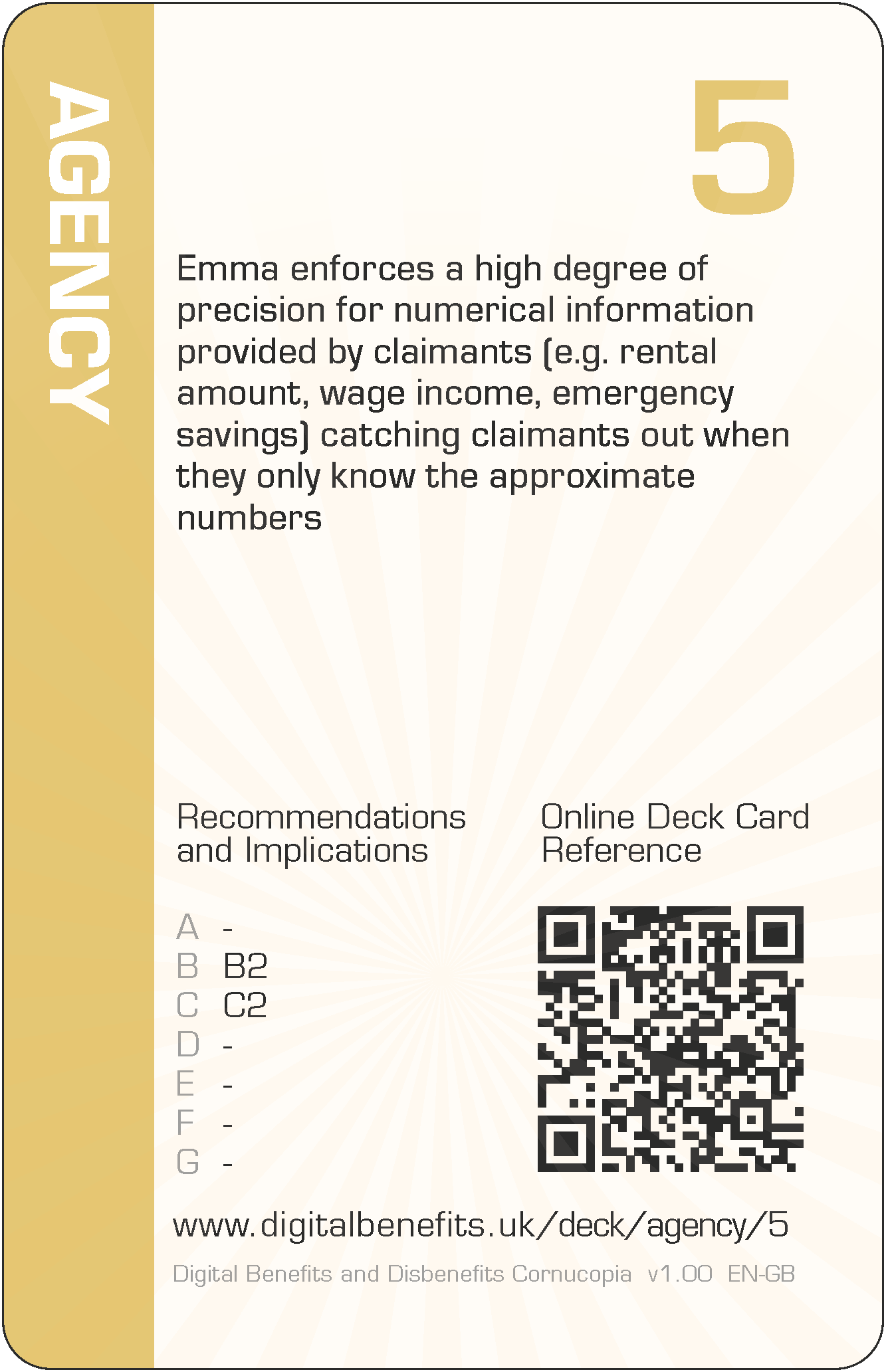Agency 5 (AG-5) Card
DBD Cornucopia > Deck > Agency > 5
Card Details - Five of Agency
Abbreviation
AG-5
Card's focus
The focus of this card is precision of claimant-submitted data
Threat to claimants
Emma enforces a high degree of precision for numerical information provided by claimants (e.g. rental amount, wage income, emergency savings) catching claimants out when they only know the approximate numbers

Threat to claimants
Emma enforces a high degree of precision for numerical information provided by claimants (e.g. rental amount, wage income, emergency savings) catching claimants out when they only know the approximate numbers.
Some examples of how this threat could lead to harms (negative effects on claimants)
The design recommendations and implications relevant to the card are listed below in the next section, but even those can be somewhat abstract and difficult to think about during practical day-to-day implementation. Therefore, some example harms are provided to complement the more formal research outputs. These examples are unique per card, and are only published on these web pages (i.e. in no other project outputs).
- Very close, but rounded, rent cost figures entered by claimants are later rejected, delaying their claim
- Approximate figures are not acceptable, even temporarily, requiring greater immediate claimant effort to obtain precise numbers
- Claimants find that even when a specific address or location is unnecessary (e.g. delivery monitoring statistics), they have to provide or select a precise address or point, rather than a more general area, requiring them to share more personal information than required for the purpose
- Claimants cannot recall the exact day of a very traumatic event, and collaborating records only note the week, thus preventing claimants from receiving an additional element of the award
The examples are to help understand the threat on the card, not to suppress thinking and innovation. Incorporating these examples exactly, or closely matching ones, should be scored down when playing DBD Cornucopia as a game.
Applicable design recommendations and implications
These are reproduced here from Research Briefing N
Acknowledge claimants as people in digital design
- Ensure system and state accountability to claimants
Equalise accountability between claimants and the state. Promote a sense of fairness by enforcing an expectation that service level standards for actions and response times should be similar to those expected of claimants, with related penalties not disproportionately, or only, affecting claimants. Provide tools/methods for claimants to easily check, query and challenge actions and decisions.
Reduce claimants’ interaction burdens with digital welfare
- Provide greater flexibility and accommodations for claimants in the accuracy, precision, timeliness and permanence of the remaining information they provide
Design for people's lives which can be complex and where changing events and circumstances, often beyond their control, drive their need and eligibility for social protection payments. Allow adequate, rather than complete and precise, data that suffice for the state's needs. Increase flexibility of use by avoiding strict deadlines; limiting the use of actions that block progression; permitting correcting, updating and reversing information; and withdraw penalties for simple slips and lapses.
General Notes
Card values (i.e. '5' for this card) are for game play and are not correlated with the severity of harm. This is because threats cannot be ranked directly since they can affect individuals in different ways due to situations and circumstances, or affect fewer or more claimants, or the harms can arise in claimants' support networks and wider society.
The threat description uses a person's name as the "attacker" (i.e. 'Emma' for this card), which can be thought of someone involved with implementation. They could have any role which influence digitisation. So they could be a database administrator, or a copy writer, or a quality assurance specialist, etc, or all of these. Everyone could have some influence on the claimant threat described. The names were randomly selected from those currently most popular as given names for boys and girls (UK Office for National Statistics).
The example harms provided are drawn from the research data (which explored not only parts of existing services but also the effects of possible changes to those), from the author's own knowledge of web application development and testing, the author's own experience of helping citizens to claim Universal Credit (UC) and Personal Independence Payment (PIP), and from suggestions submitted by other people (make a suggestion). The threats and example harms do not necessarily exist in the current UC or PIP deployments or in ecosystems around those services, but they might well do.
All the cards in this Agency suit are: 2 3 4 5 6 7 8 9 10 J Q K A
The other suits in the deck are: Scope, Architecture, Trust, Porosity and Cornucopia (plus Jokers).
